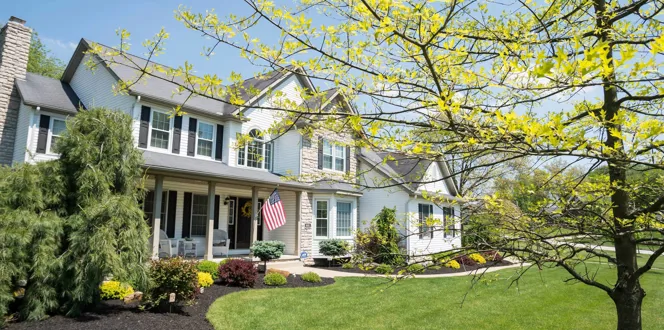We expect to see tree roots stretch themselves far and wide into our landscapes. What we don’t expect to see is cooped up roots wrapped around our tree’s trunk.
But, it happens. It’s called girdling—when tree roots encircle a tree’s trunk. If you had to describe it, you might say it looks like roots are choking or strangling your tree.
Turns out, that’s exactly the case. Girdling roots do suffocate trees by cutting off the flow of food and water. Below, read more about what exactly happens to a tree with girdled roots, and learn what you can do to help.
What are stem girdling roots?
Stem girdling roots are roots that wrap fully or partially around a tree’s trunk. This can happen above ground, meaning the encircled roots are visible. But it can also happen just below the soil surface where we can’t see the issue.
Any tree can suffer from girdling roots, but maple and linden trees are most susceptible.
What causes girdling roots?
More often than not, tree girdling roots are caused by improper planting. That could mean a lot of things, like:
- Planting in a hole that’s too small, which prevents roots from spreading out.
- Making the planting hole too deep, which forces roots to grow up toward the surface in search of water and air.
- Planting a container plant without loosening up its circling roots.
Some post-planting actions can result in girdled roots, too. Most commonly, piling too much mulch up against a tree trunk (a.k.a, volcano mulching) can lead to girdling roots.
Girdling root tree symptoms and detection
If the girdled roots are above-ground, they’re easy to identify. But, since girdling can also happen just below the soil surface, you’ll have to look out for other clues.
Girdling roots prevent nutrients from being transported down to tree roots, and they prevent water movement back up to tree leaves. That deprivation takes a toll on trees, and it comes across in a few common symptoms. Your tree may have girdling roots if:
- Tree canopy looks thin;
- Leaves change color or drop well before the fall season;
- There are dead, leafless branches in the canopy;
- And—this is a big one—one side of the trunk looks like it’s going straight into the ground like a pole with no natural flare.
Girdling roots treatment and removal
Girdling tree root removal requires digging up the soil from around the trouble-making root and removing it with a tool like a chisel or saw. Check out this video to hear more about the removal process from Davey arborist Lou Meyer.
How do you remove girdling tree roots?
If you inherited this problem, deciding to remove girdling roots depends on many factors. Trees sometimes have a complicated relationship with girdling roots. Yes, the roots are hurting the tree, but at the same time, they could be supplying the tree with nutrients and water and helping the tree stabilize its structure.
For that reason, you should consult with a certified arborist for help with cutting girdling tree roots.





